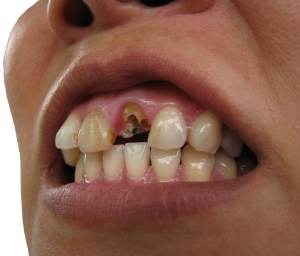The severity of a tooth fracture can vary from a crack in the crown to a crack lengthwise in the entire tooth (split tooth) to a broken off tooth.
The tooth that is visible is about 1/3 of the total tooth length and is called the crown of the tooth. The 2/3 of the tooth buried in the bone is called the root of the tooth. In the center of the tooth is the pulp; the outer shell is made up of white enamel, the harder outside shell and the yellow dentin is just underneath it. When a tooth fracture occurs the dentist needs to assess the nature of the fracture (length of it , direction within the tooth, injury to the pulp or not).
A bad habit of grinding the teeth (bruxism) predisposes the person to tooth fractures. If the patient is able to present with the avulsed tooth within an hour of the accident, the dentist may be able to re-implant the tooth. However, the tooth should be kept moist in milk (or 0.9% saline solution) without manipulations of the root where the vital periodontal ligament remnants will help increase the chance of tooth survival when re-implanted. Antibiotics are usually also given for a period of time.
The dentist can splint a loose fractured tooth to the adjacent teeth for a period of time until the tooth is re-implanted. If the tooth does not grow back in, the tooth is unstable and is loose. In this case the tooth needs to be extracted. At a later date a tooth implant needs to be done to close the gap. This will protect the adjacent teeth and will also save the opposite tooth. For teeth to stay healthy they need the chewing action, which maintains their ligamentous support structure. If following the splinting procedure a tooth fracture heals, the tooth needs to be checked by the dentist for some time to ensure that there is no root infection. This is achieved with periodic dental X-rays.
References:
1. Suzanne Somers: “Breakthrough” Eight Steps to Wellness – Life-altering Secrets from Today’s Cutting-edge Doctors”, Crown Publishers, 2008
2. http://www.webmd.com/oral-health/dental-root-canals
3. http://www.aacd.com/whitening
4. http://www.nhs.uk/conditions/Gum-disease/Pages/Introduction.aspx
5. http://www.aae.org/patients/treatments-and-procedures/root-canals/root-canals.aspx
6. http://en.wikipedia.org/wiki/Dental_trauma
7. http://www.dailymail.co.uk/health/article-25286/The-complete-guide-cosmetic-dentistry.html







